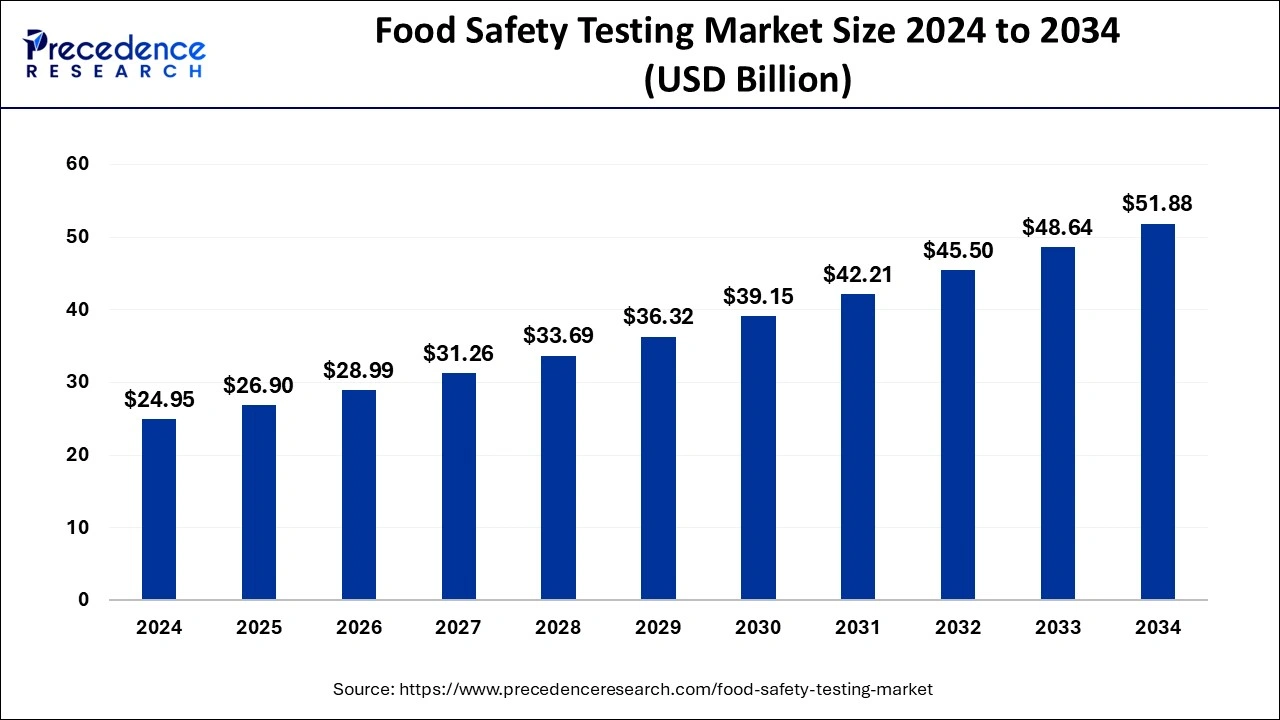The global food safety testing market is valued at USD 24.95 billion in 2024 and is expected to reach USD 51.88 billion by 2034, growing at a CAGR of 7.59%.

- In 2024, Asia Pacific emerged as the leading region in the food safety testing market with a 41% share.
- The processed food segment held 37% of the market and is expected to grow at the highest CAGR.
- Pathogen testing remained the most significant category, comprising 42% of the market share in 2024.
Detailed Overview
The food safety testing market is experiencing rapid growth due to increasing concerns over foodborne illnesses, contamination, and the need for regulatory compliance. With globalization in the food supply chain, ensuring food safety has become a critical priority for governments, food manufacturers, and consumers. Advanced testing methods, including PCR-based assays, chromatography, and immunoassay techniques, are widely used to detect pathogens, allergens, toxins, and contaminants. The demand for rapid testing solutions is rising as food producers seek efficient methods to prevent recalls and ensure compliance with stringent safety standards. Additionally, technological advancements such as blockchain-based traceability and AI-driven testing solutions are revolutionizing the industry.
Drivers
One of the key drivers of the food safety testing market is the growing incidence of foodborne diseases, which affect millions of people worldwide each year. Governments and regulatory agencies are enforcing strict food safety regulations, compelling manufacturers to adopt comprehensive testing protocols. The rise in consumer awareness regarding food quality and safety has also increased demand for transparent labeling and stringent testing procedures. Additionally, advancements in testing technologies, including next-generation sequencing and biosensors, are improving detection accuracy and efficiency, further fueling market growth.
Opportunities
The increasing demand for processed and packaged foods presents significant growth opportunities for the food safety testing market. As food production becomes more complex, the risk of contamination rises, driving the need for robust testing solutions. The emergence of smart testing technologies, such as portable testing kits and AI-driven analysis, offers new possibilities for real-time monitoring. Additionally, developing economies in Asia-Pacific and Latin America are investing in food safety infrastructure, creating expansion opportunities for testing service providers. Collaborations between governments and private companies to enhance food safety standards are also contributing to market growth.
Challenges
Despite its growth, the food safety testing market faces several challenges, including high costs associated with advanced testing technologies. Small and medium-sized food manufacturers often struggle to afford comprehensive testing solutions, limiting market penetration. Variability in food safety regulations across different regions also poses challenges for international food producers and exporters. Additionally, the complexity of testing multiple contaminants in diverse food matrices increases the need for specialized expertise, making testing procedures more time-consuming and resource-intensive. The risk of false positives or negatives in rapid testing methods remains another critical concern that affects market credibility.
Regional Insights
North America dominates the food safety testing market due to stringent food safety regulations, well-established testing infrastructure, and the presence of major food manufacturers. Europe follows closely, driven by strict EU regulations and increasing consumer demand for high-quality food products. The Asia-Pacific region is witnessing the fastest growth, fueled by rising concerns over food safety, increasing food exports, and government initiatives to strengthen food quality standards. Meanwhile, Latin America and the Middle East are emerging markets with growing investments in food safety testing to prevent contamination risks and meet international trade requirements.
Recent News
Recent developments in the food safety testing market include advancements in rapid testing technologies, enabling faster and more accurate detection of contaminants. Companies are increasingly adopting blockchain-based traceability solutions to enhance food safety transparency and reduce the risk of food fraud. Regulatory bodies worldwide are tightening food safety standards, prompting food manufacturers to invest in cutting-edge testing solutions. Additionally, the integration of artificial intelligence and big data analytics in food safety monitoring is gaining traction, helping to identify contamination risks more efficiently and improve overall food security.
Food Safety Testing Market Companies
- SGS S.A.
- Eurofins SGS Group
- TUV SUD
- Bureau Veritas
- Intertek
- Agilent Technologies Inc
- Thermo fisher Scientific Inc
- Shimadzu Corporation
- PerkinElmer Inc
By Food Tested
- Beverages
- Meat, poultry, & seafood products
- Dairy & dairy product
- Cereal, grain, & pulse
- Processed food
- Others
By Target Tested
- Pathogens
- E. coli
- Salmonella
- Campylobacter
- Listeria
- Others
- Pesticides
- GMOs
- Mycotoxin
- Allergens
- Heavy metals
- Others
By Technology
- Traditional
- Rapid
- Convenience-based
- Polymerase chain reaction (PCR)
- Immunoassay
- Chromatography & spectrometry
By Regional Outlook
- North America
- U.S.
- Canada
- Europe
- U.K.
- Germany
- France
- Asia Pacific
- China
- India
- Japan
- South Korea
- Middle East & Africa
- Latin America